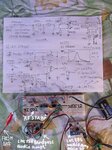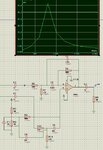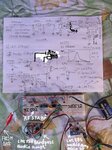truffaldino
Junior Member level 3

Hello,
I have collected a direct conversion receiver on 3 breadboards: the first one contains rf stage, the second one contains opamp audio preamplifier/bandpass filter and the third LM386 audio amp in minimal configuration with gain 20.
The rf part is based on NE612 famous mixer. The receiver works quite weel (I can hear 10 nanowatt beeping transmitter from other end of my appartment) but it makes a noise or a steady continous sound unless I put my fingers on ne612 chip and connecting wires between RF breadboard and audio preamp breadboard.
I know that one should not make rf circuits on breadboard, but how can one deal with such problems?
I am attaching picture of schematics and the circuit.
I would like to avoid soldering etc.
Thanks in advance
Truffaldino
Thanks in advance
I have collected a direct conversion receiver on 3 breadboards: the first one contains rf stage, the second one contains opamp audio preamplifier/bandpass filter and the third LM386 audio amp in minimal configuration with gain 20.
The rf part is based on NE612 famous mixer. The receiver works quite weel (I can hear 10 nanowatt beeping transmitter from other end of my appartment) but it makes a noise or a steady continous sound unless I put my fingers on ne612 chip and connecting wires between RF breadboard and audio preamp breadboard.
I know that one should not make rf circuits on breadboard, but how can one deal with such problems?
I am attaching picture of schematics and the circuit.
I would like to avoid soldering etc.
Thanks in advance
Truffaldino
Thanks in advance





